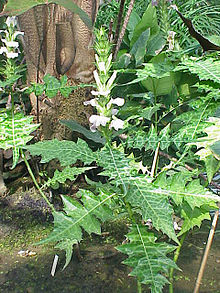Acanthus (plant)
| Acanthus | |
|---|---|

| |
| Acanthus montanus | |
| Scientific classification | |
| Kingdom: | Plantae |
| Clade: | Tracheophytes |
| Clade: | Angiosperms |
| Clade: | Eudicots |
| Clade: | Asterids |
| Order: | Lamiales |
| Family: | Acanthaceae |
| Subfamily: | Acanthoideae |
| Tribe: | Acantheae
|
| Genus: | Acanthus L. (1753) |
| Species | |
|
See text | |
| Synonyms[1][2] | |
| |
Acanthus is a
The genus comprises
bearing white or purplish flowers. Size varies from 0.4 to 2 m (1.3 to 6.6 ft) in height.Species
29 species are accepted:[1]
- Acanthus albus Debnath, B.K.Singh & P.Giri
- Acanthus arboreus Forssk. (1775)
- Acanthus austromontanus Vollesen
- Acanthus carduaceus Griff.
- Acanthus caroli-alexandri Hausskn. (Syn. Acanthus greuterianus Snogerup, B.Snogerup & Strid (2006)[5][6]) — This species was discovered in NW Greece.
- Acanthus caudatus Lindau
- Acanthus dioscoridis Willd.
- Acanthus ebracteatus Vahl — This species occurs in South Asia, including Brunei Darussalam, China, South Taiwan, India, Malaysia, Philippines, Singapore, Thailand, Viet Nam, Cambodia, and Indonesia. In Australasia it is found in northeast Australia, northwest Australia, Papua New Guinea, and the Solomon Islands.
- Acanthus eminens C.B.Clarke — native to tropical Africa
- Acanthus flexicaulis Bremek.
- Acanthus gaed Lindau
- Acanthus guineensis Heine & P.Taylor
- Acanthus hirsutus Boiss. — native to Turkey, Syria
- Acanthus hirsutus subsp. syriacus (Syn. Acanthus syriacus Boiss.[7]) — native to the Eastern Mediterranean region
- Acanthus ilicifolius L. — native to India and Sri Lanka
- Acanthus kulalensis Vollesen
- Acanthus latisepalus C.B. Clarke (1899)
- Acanthus leucostachyus Wall. ex Nees. (1832)
- Acanthus longibracteatus Kurz (1870)
- Acanthus mayaccanus Büttner (1890)
- Acanthus mollis L. — native to Mediterranean Europe
- Acanthus montanus (Nees) T.Anders. — West and Central African species, from Ghana in the west to Angola and the Democratic Republic of Congo.
- Oliv.
- Delile— native to Burundi, Rwanda, DRC, Uganda, Sudan, Ethiopia, Kenya, Tanzania.
- Acanthus sennii Chiov.
- Acanthus seretii De Wild.
- Acanthus spinosus L. — native to southern Europe
- Acanthus villaeanus De Wild.
- Acanthus volubilis Wall.
Cultivation and uses

Acanthus leaves were the aesthetic basis for
.
Acanthus leaves also have many medicinal uses. diabetes, leprosy, hepatitis, snake bites, and rheumatoid arthritis.[10] The leaves of Acanthus ebracteatus, noted for their antioxidant properties, are used for making Thai herbal tea in Thailand and Indonesia.[11]
References
- ^ a b Acanthus L. Plants of the World Online. Retrieved 26 January 2024.
- ^ "Acanthus". Germplasm Resources Information Network. Agricultural Research Service, United States Department of Agriculture.
- Perseus Project. Harper, Douglas. "acanthus". Online Etymology Dictionary.
- ISBN 978-0-8493-2675-2.
- S2CID 85054771.
- ^ "Acanthus greuterianus Snogerup, B.Snogerup & Strid – The Plant List". www.theplantlist.org. Retrieved 2017-12-13.
- ^ "Acanthus syriacus Boiss". Germplasm Resources Information Network. Agricultural Research Service, United States Department of Agriculture.
- ^ "African Plant Database". Les conservatoire et jardin botaniques de la Ville de Genève (Conservatories and Botanic Gardens of the City of Geneva). Retrieved 2 February 2019.
- S2CID 38592501.
- S2CID 129317332.
- ^ Chan, E. W.; Eng, S. Y.; Tan, Y. P.; Wong, Z. C.; Lye, P. Y.; Tan, L. N. (2012). "Antioxidant and Sensory Properties of Thai Herbal Teas with Emphasis on Thunbergia laurifolia Lindl". Chiang Mai Journal of Science. 39 (4): 599–609.
External links
- Flora Europaea: Acanthus
- Images of Acanthus
- "Acanthus L." Atlas of Living Australia.
- Chisholm, Hugh, ed. (1911). . Encyclopædia Britannica (11th ed.). Cambridge University Press.
 Media related to Acanthus at Wikimedia Commons
Media related to Acanthus at Wikimedia Commons Data related to Acanthus at Wikispecies
Data related to Acanthus at Wikispecies
